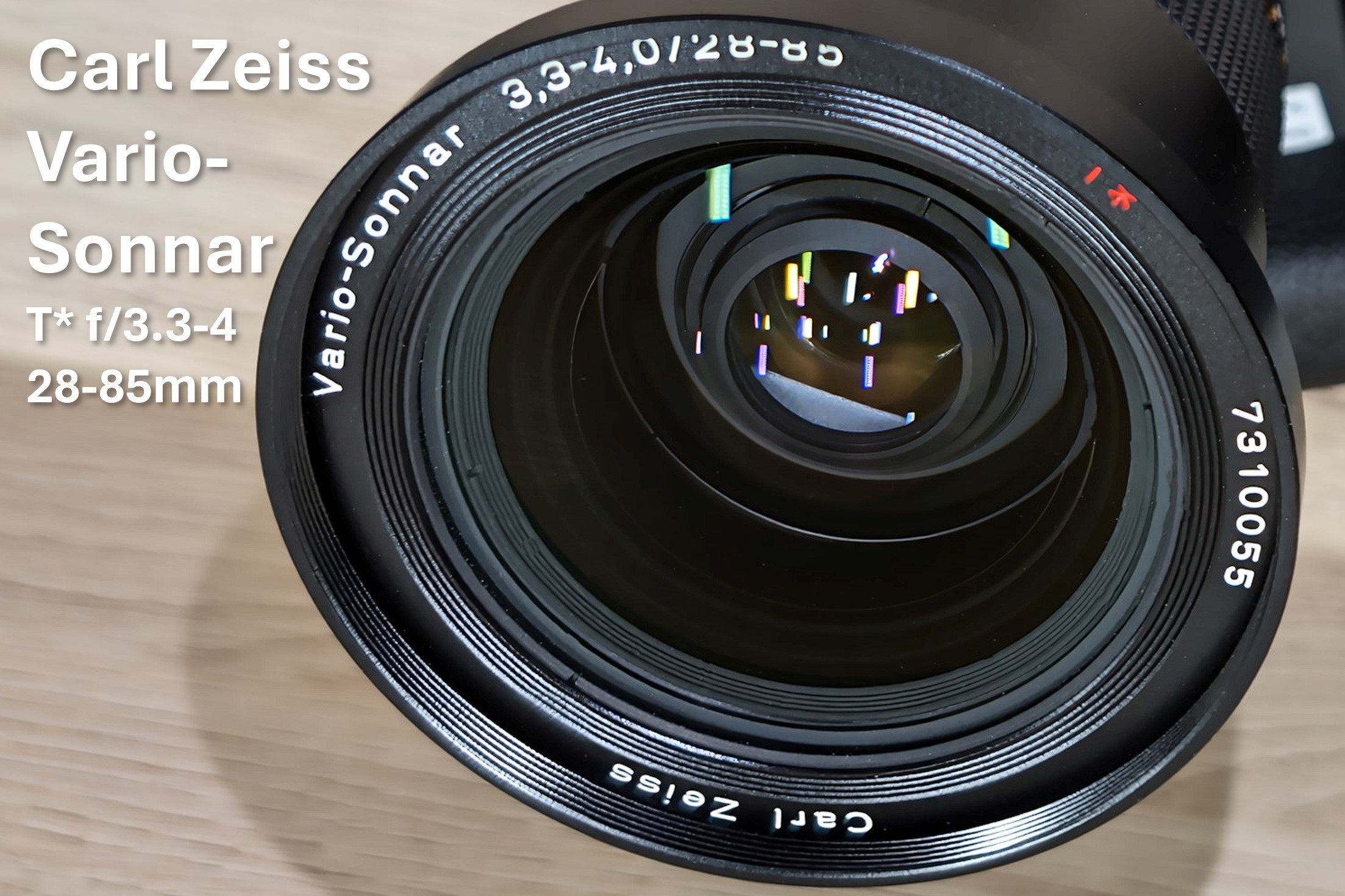Abstract: In this article, I will examine the image and bokeh quality of a 35+ year old, inexpensive Carl Zeiss 28-85mm f/3.3-4 Vario-Sonnar zoom lens by comparing it to a modern Tamron 17-70mm f/2.8 zoom lens.
The Carl Zeiss Vario-Sonnar T* f/3.3-4.0 28-85 mm lens, introduced in 1988, has received considerable praise:
Excellent image quality over its entire focal length range – so good in fact that it can be readily compared to lenses with fixed focal lengths
https://www.zeiss.com
“The bokeh is simply STUNNING – so smooth and creamy!
The bokeh is the No.1 special feature of this lens”
https://www.pentaxforums.com
“An exceptional lens that, even today,
is an absolute surprise in image quality”
https://lens-db.com
“Colors, microcontrast and general contrast
are all typical Zeiss, meaning: whoa!“
addicted2light.com
Let’s take a closer look at the image and bokeh quality of the Carl Zeiss Vario-Sonnar Classic lens while shooting at a famous annual vintage car event southeast of Munich, Germany in 2024.
When you click on an image in the galleries, following buttons will allow you to select some features. Use Original-size to watch the photo in full resolution:
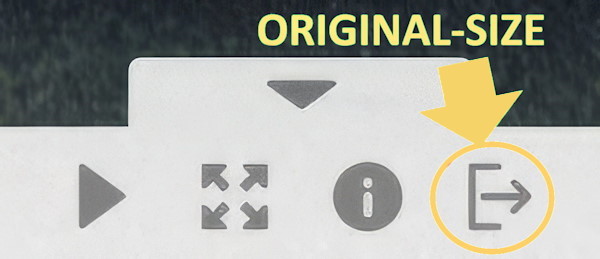
Slideshow | Fullscreen | Image-Info | Original-size
The Carl Zeiss lens was adapted to a Sony A7CII full-frame camera with a resolution of approximately 32 megapixels. Most of the photos were taken around 35mm and at 85mm focal length.
Here are photos of the Tamron 17-70mm f/2.8 APS-C lens taken at the same vintage car event in 2023
Bad bokeh? Tamron 17-70mm f2.8 lens bokeh review shooting classic cars
Main specs of the Carl Zeiss Vario-Sonnar T* 28-85mm f/3.3-4 full-frame vs. Tamron 17-70mm f/2.8 APC-C lens
Let us compare the Zeiss lens with the famous Tamron 17-70mm f/2.8 APS-C lens on a Sony a6400 camera to see if the old Zeiss lens delivers comparable image quality and bokeh compared to a modern zoom lens.
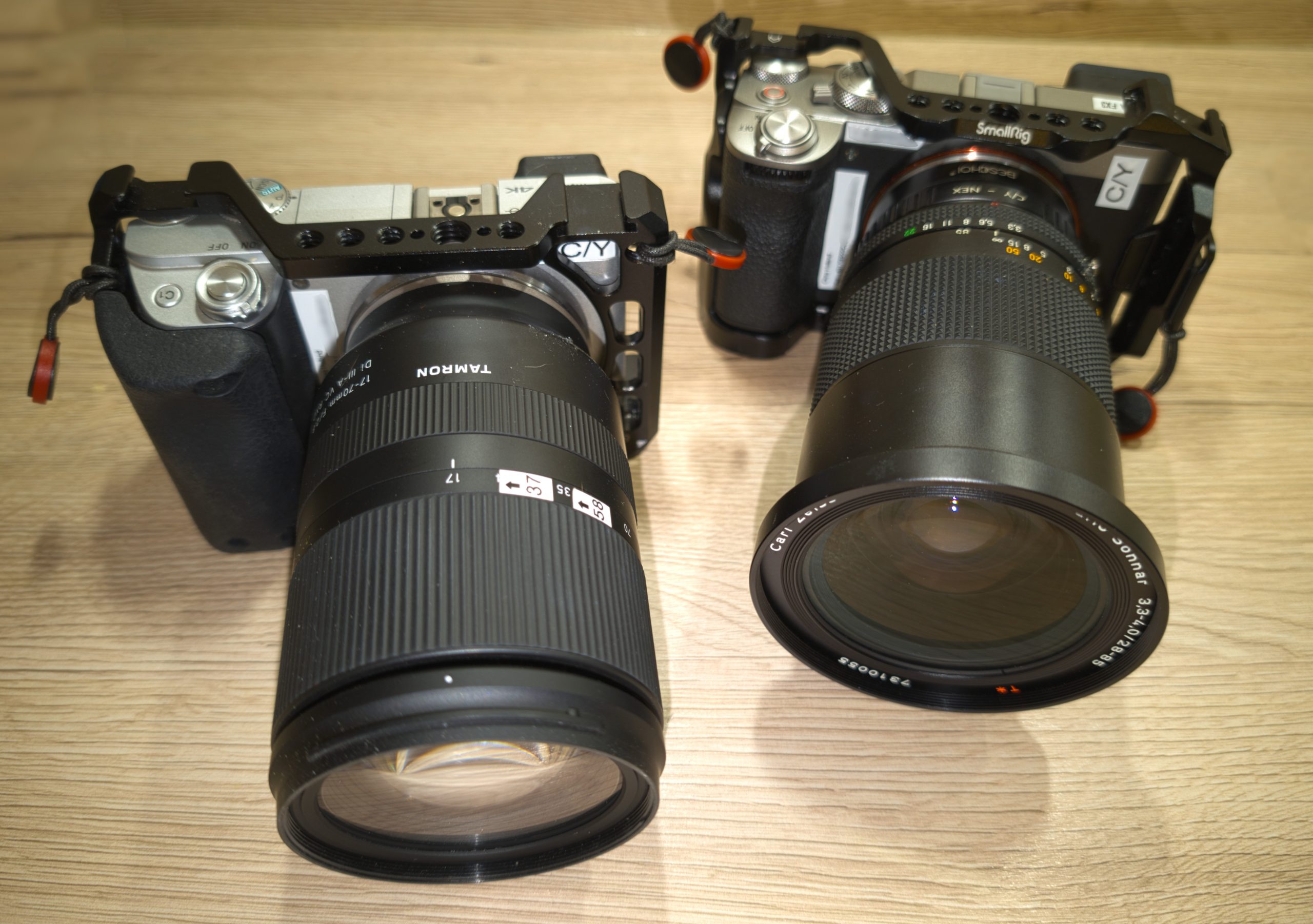
- According to the official specifications of the Zeiss Vario-Sonnar lens, the Zeiss has a focal length range of 29-82.4mm, while the Tamron 17-70mm lens has approximately a field of view of an approx. 26.1-107.3mm full-frame zoom lens (taking into account the crop factor 1.534 of a Sony a6400 or a6600 APS-C camera)
- The Zeiss is a one-touch zoom lens, the same ring is used for zooming and focusing vs. the Tamron is a 2-ring focus and zoom lens
- The Zeiss has 16 lens elements in 13 groups with highly efficient T* coating vs. the Tamron has 16 lens elements in 12 groups
- The Zeiss weights approx. 735g, has a size of 98mm length x 85mm diameter and a 82mm filter thread vs. the Tamron weights 525g, has a size of 119mm length x 75mm diameter and a 67mm filter thread
- The Zeiss has Contax/Yashica mount, the lens needs an adapter to be used on a Sony a7 full-frame camera which means the Zeiss lens is manual focusing only vs. the Tamron has a Sony e-mount with excellent auto-focus and lens-internal optical stabilization
- The Zeiss has a minimal focus distance of 0.6m vs. Tamron 0.19m
- The Zeiss gets shorter at the telephoto range of 85mm which is quite unusual and extends in lens length for wide angle 28mm vs. the Tamron extends in lens length for telephoto 70mm focal length
- The Zeiss had a price of approx. EUR 1.050 in 1992 and is available as used vintage lens for approx. EUR 280 vs. the price of the modern Tamron lens is approx. EUR 700
Pixel Peeping Exercise with Banksy
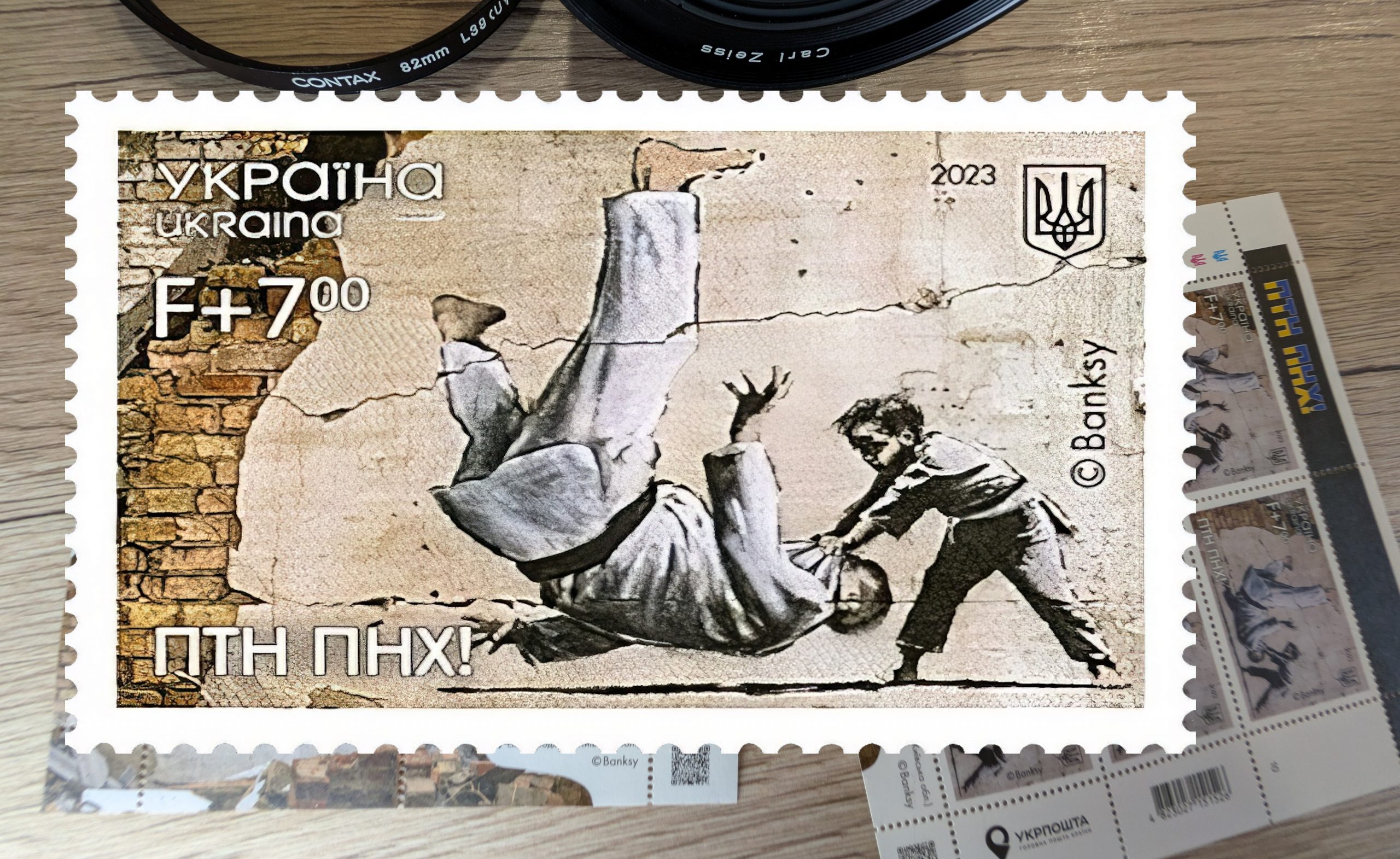
Read more about Banksy’s activities in Ukraine here on BBC News: https://www.bbc.com/news
I added Google Pixel 8 Pro photos with 50- and 48-megapixel resolution in Pro mode and 24mm and 120mm focal length to compare the “state of the art” of modern smartphone cameras. The inclusion of the Pixel 8 Pro is for informational purposes only. The open aperture of f4 on the Zeiss full-frame lens compares quite well to the open aperture of f/2.8 on the Tamron APS-C lens, considering a crop factor of about 1.5.
When you click on an image in the galleries, following buttons will allow you to select some features. Use Original-size to watch the photo in full resolution:

Slideshow | Fullscreen | Image-Info | Original-size
For comparison, photos were taken with the Carl Zeiss and Tamron lenses at 35mm and 85mm full-frame equivalent focal lengths at the center and corners of the lens. The Pixel 8 Pro phone camera was shot at 25mm and 120mm full-frame equivalent focal lengths with the Hi-Res option enabled in the Pixel Camera app’s PRO mode to capture high-resolution images at 50 and 48 megapixels. Any non-Hi-Res photo mode or focal length between 25mm and 120mm will produce a 12-megapixel photo from the Pixel 8 Pro camera that is too far off in image quality to be meaningfully compared to the Zeiss and Tamron photos.
Carl Zeiss and Tamron Zoom Lenses Bokeh Comparison
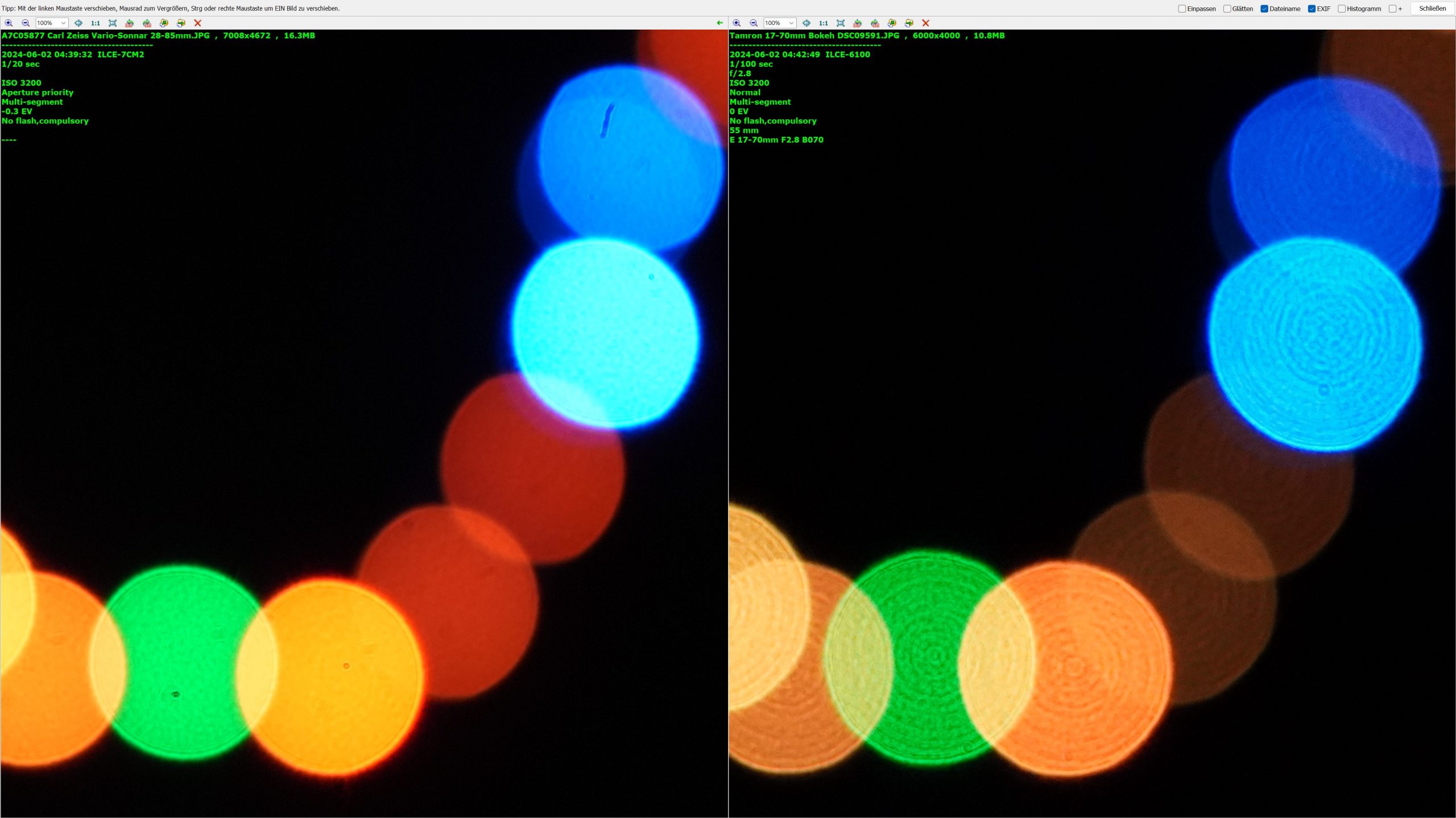
Rundown
In my opinion and despite its age, the Carl Zeiss Vario-Sonnar T* 28-85mm is a surprisingly good and inexpensive full-frame lens for the use case of vintage car or similar events. And because it is a zoom lens, there is no need to change lenses to change the field of view between wide angle and telephoto. And please believe me, continuously switching multiple prime lenses or carrying around another camera body at these larger events is something you do only once and never again.
With the Zeiss Vario-Sonnar, you must be comfortable with manual focus. But for a vintage car event use case, manual focus is preferable to autofocus anyway, in my view. The old Zeiss classic zoom lens delivers very good image and bokeh quality and really shines with its bokeh at 85mm.
The much-hyped modern Tamron 17-70mm f/2.8 is a very versatile APS-C lens with excellent autofocus and optical lens stabilization, but when it comes to beautiful, creamy bokeh at the telephoto end, the Zeiss Vario-Sonar lens excels and takes your photos to a higher level.
Better avoid using the Zeiss Vario-Sonnar lens at a focal length below 35mm due to its poorer performance in chromatic aberration, softness, and vignetting.
The above assessments are not statements of fact, but merely my own humble private opinions.
Check out Steven Tanno’s informative videos comparing the classic Carl Zeiss Vario-Sonnar 28-85mm with the modern Tamron 28-75mm full-frame lens
Learn more about the very unique Bubble Bokeh watching Simon’s review of the modern TTArtisan 100mm f/2.8 lens
Don’t hesitate to leave a comment below
Your comments are highly valued. Please note that comments undergo manual verification to prevent spam, which may cause a delay in their appearance.
